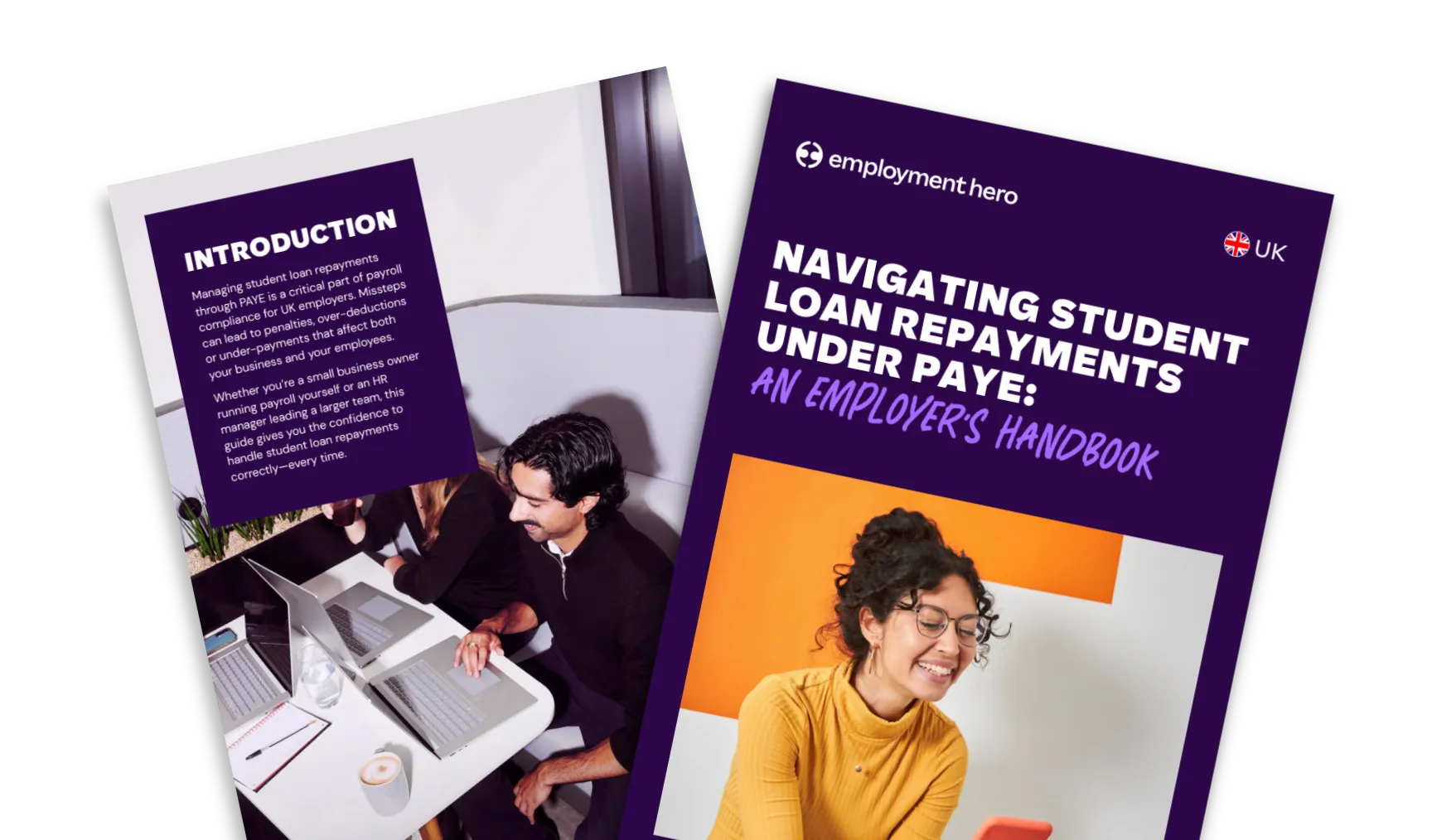Navigating Student Loan Repayments Under PAYE: An Employer’s Handbook
Published
Navigating Student Loan Repayments Under PAYE: An Employer’s Handbook
Published
Managing student loan repayments through PAYE is a critical part of payroll compliance for UK employers. Missteps can lead to penalties, over-deductions or under-payments that affect both your business and your employees.
This handbook is designed to guide HR managers and business owners through the essentials of student loan repayments, from understanding repayment plans to automating deductions with intelligent payroll software.
What is in this handbook?
- Thresholds and rates for 2025
- Common mistakes and how to avoid them
- Loan plan identification flowchart
- Repayments checklist
How do student loans work in the UK?
Understanding student loan repayments is key to running compliant payroll in the UK. But it’s important to keep in mind that not all repayments are the same and they depend on an individual’s plan; each plan has its own income threshold and repayment rate. Don’t forget that these thresholds change annually, so staying updated is crucial.
Here’s a breakdown of the four main plans for the 2025/26 tax year.
Plan 1
For students who started undergraduate courses before September 2012 in England and Wales, or Scottish and Northern Irish borrowers with older fees.
- 2025/26 threshold: £26,065 per year.
- Repayment rate: 9% of earnings above the threshold.
Plan 2
For English and Welsh students who began undergraduate courses on or after September 2012.
- 2025/26 threshold: £28,470 per year.
- Repayment rate: 9% of earnings above the threshold.
Plan 4
For Scottish students with tuition fees issued by the Student Awards Agency Scotland (SAAS).
- 2025/26 threshold: £32,745 per year.
- Repayment rate: 9% of earnings above the threshold.
Postgraduate Loan (PGL)
For postgraduate Master’s or Doctoral students across the UK.
- 2025/26 threshold: £21,000 per year.
- Repayment rate: 6% of earnings above the threshold.
How are student loan repayments calculated?
One of the biggest questions business owners and HR managers have is about how student loan repayments are calculated. So we’re going to break it down.
Student loan repayments are based on an employee’s gross income (before tax and National Insurance). Employers must calculate the repayment amount once earnings exceed the relevant plan’s threshold.
For example, if an employee on Plan 2 earns £30,000 annually:
- Threshold: £28,470
- Income above threshold: £30,000 – £28,470 = £1,530
- Repayment rate: 9% × £1,530 = £137.70 per year (around £11.48 per month
The calculation adjusts automatically as pay fluctuates. If earnings fall below the threshold in a given pay period, no repayment is deducted for that period.
In order to stay up to date with ever-changing regulations, business owners and HR professionals should regularly review HMRC’s published thresholds and rates. As a general rule, these figures may change each April at the start of the new tax year.
Do you pay tax on student loan repayments?
A common misconception is that student loan repayments are a form of tax. In reality, they are not an additional tax. Instead, they are treated as a separate deduction collected alongside Income Tax and National Insurance contributions via PAYE.
Employers report these deductions on payslips to provide transparency. Repayments reduce take-home pay but do not affect tax codes or alter the amount of income tax due.
How repayments are made through PAYE
Employers are responsible for deducting and forwarding student loan repayments to HMRC. The process works as follows:
- HMRC Notification:
Employers receive a ‘Start Notice’ (SL1) from HMRC indicating that an employee is due to begin repayments and specifying the plan type. Similarly, a ‘Stop Notice’ (SL2) is issued when repayments should end.
- Payroll Deduction:
The payroll system calculates repayments based on the employee’s earnings above the threshold, using the rate for their plan.
- Payslip Reporting:
Deductions appear on the employee’s payslip as a separate line item labelled ‘Student Loan’ or ‘Postgraduate Loan.’
- Payment to HMRC:
Repayments are included in the employer’s regular PAYE submission and paid to HMRC together with income tax and NIC.
Employers must ensure that payroll records are up to date, as failing to act on start or stop notices can lead to incorrect deductions and compliance issues.
Navigate student loan repayments with confidence with Employment Hero
Keeping up with student loan repayments under PAYE can feel overwhelming—especially with changing thresholds, multiple loan plans and strict HMRC reporting rules. That’s why we’ve created this free downloadable resource to make it simple for you.
Inside, you’ll find:
- Thresholds and rates for 2025
- Common mistakes and how to avoid them
- Loan plan identification flowchart
- Repayments checklist
Whether you’re onboarding new employees or managing complex payroll, this guide gives you the tools to stay compliant, avoid errors and save valuable time.
Register for the guide
Related Resources
-
 Read more: Navigating Student Loan Repayments Under PAYE: An Employer’s Handbook
Read more: Navigating Student Loan Repayments Under PAYE: An Employer’s HandbookNavigating Student Loan Repayments Under PAYE: An Employer’s Handbook
Understand your role in managing student loan repayments through PAYE. Learn how calculations work, repayment plans, and your responsibilities.
-
 Read more: Payday Super factsheet: What employers need to know
Read more: Payday Super factsheet: What employers need to knowPayday Super factsheet: What employers need to know
Learn what Australia’s Payday Super changes mean for your business. Learn how Employment Hero can help you manage super payments…
-
 Read more: Payday Super cash flow impact checklist
Read more: Payday Super cash flow impact checklistPayday Super cash flow impact checklist
Businesses will need to strengthen cash flow management and streamline internal processes to meet the new deadlines set by upcoming…























